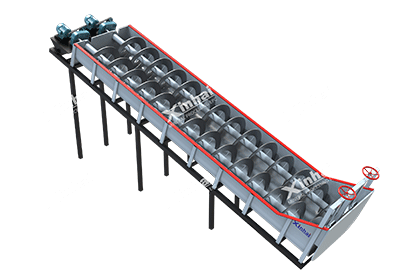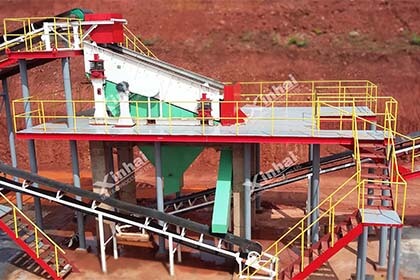7 Types of Mining Feeders You Need to Know
 Shirley
Shirley
 May 31, 2021
May 31, 2021
 2903
2903
If you want to know more details about equipment, solutions, etc, please click the button below for free consultation, or leave your requirements!
At present, the commonly used feeders in mines include belt feeders, chute feeders, disc feeders, pendulum feeders, vibrating feeders, electromagnetic vibrating feeders and plate feeders. This post will take you to understand the various types of feeders and their application one by one, and help you choose the right feeder.
01 Belt Feeder
Back
Belt feeder is an equipment that can continuous feeding withstand greater pressure. The material is fed from the hopper to the belt surface. With the rotation of the AC speed control motor, the belt moves forward slowly feeding the material to the next working stage.
Belt feeder is mainly used for conveying various block, granular and bulk materials, whose feeding capacity is between 10 and 450t/h. In beneficiation production, to meet the needs of different layout types of operation, the mine owner can use a single feeder to convey materials, or set up a horizontal or inclined conveying system by multiple or combine with other conveying equipment.
02 Chute Feeder
Back
The chute feeder has been applied earlier and has many types, which is equipped with an adjusting gate that can control the height of the material layer. The lower part of the feeding chute is equipped with a feed plate that can move forward and backward. This kind of feeder can be erected on the ground or hoisted on the discharge port of the ore bin. The feed size of the larger chute feeder is less than 500mm. In practice, the commonly used feeder model is 980*1240 with 350-0mm feed size.
The chute feeder which is not suitable for viscous materials, is usually applied for short-distance feeding. It often used to feed some small particles which is under 35-100 mm.
3. Disc Feeder

When the feeder is working, the motor drives the disc mounted on the worm reducer to rotate through the pulley. Bulk materials loading into the receiving cylinder from the hopper are piled on the disc. You can adjust the gap between the sleeve and the disc by adjusting the bolt to control the natural angle of materials piles. When the disc rotates, the material is evenly scraped outside by the discharge knife, so that as the disc rotates, the material is evenly fall into the receiving hopper. you can also control the amount of feed by adjusting the gap between the unloading knife and the disc.
The disc feeder is suitable for feeding various non-sticky materials. It is often used for feeding fine ore below 20mm, but not suitable for feeding powdery materials with good fluidity.
03 Pendulum Feeder
Back
The working principle of the pendulum feeder is that the motor decelerates through the V-belt reducer creating a kind of decelerated power which transmitted to the eccentric wheel; Then the eccentric wheel passes through the connecting rod to drive the pendulum bottom plate to swing back and forth. The ore in the ore bin passing through the inner cavity, is discharged out at a uniform speed which can ensure uniform feeding to the ball mill.
Pendulum feeders mostly feed for ball mills and belt conveyors. They are very suitable for 35-50mm particles’ short-distance transmission and conveying, whose production capacity is between 0-25t/h.
However, the pendulum feeder is not suitable for conveying dry powder or materials with too large granularity. Because it is prone to dust pollution or clogging of the discharge port. When you chose this kind of feeder, you should pay attention to the fed materials, so as not to affect the work efficiency.
04 Vibrating Feeder
BackThe vibrating feeder is a mechanical vibrating mine feeder with rough screening function. The vibration exciter is composed of two eccentric shafts that must be meshed with gears according to the mark. When the motor is started, the two eccentric shafts are driven to rotate, thereby generating a huge synthetic linear excitation force, which makes material slide forward on the trough to achieve the feeding purpose. When the material passes through the screen bar on the tank body, the smaller material can fall through the gap of the screen bar without crushing. At this time, the feeder plays a coarse screening role on the plant.
In the beneficiation plant, the vibrating feeder can continuously and uniformly feed materials to receiving machines, such as conveyors, bucket elevators, crushers, ball mills and other equipment. Besides, it can coarsely screen the materials.
05 Electromagnetic Vibrating Feeder
Back
The electromagnetic vibrating feeder is a relatively new type of quantitative mining feeder, which feeding materials by using an electromagnetic vibrator to drive the feeding trough to periodically reciprocate in the inclined direction. When the vertical component of the acceleration is greater than the gravitational acceleration, the material in the trough will be thrown up and jump forward according to the parabolic trajectory. The throwing and falling are completed within 1/5 second. The chute vibrates at a frequency of 3000 times per minute.
The electromagnetic vibrating feeder feeds massive, granular and powdery materials from the storage bin or hopper to the receiving device quantitatively and uniformly. As a viscous granular powder feeding device, the electromagnetic vibrating feeder can be used for automatic batching, quantitative packaging, etc., to realize automatic production.
06 Plate Feeder
Back
The working principle of the plate feeder is to use the power of the motor to make the connecting rod of the eccentric mechanism reciprocate, and the pawl pushes the ratchet to drive the active sprocket to rotate, so that the chain plate moves intermittently to achieve the purpose of conveying materials.
The plate feeder can be divided into heavy, medium and light plate feeders.
The heavy-duty plate feeder is suitable for short-distance transportation of bulk materials with a feeding size of 1000mm; the medium-duty plate feeder is suitable for short-distance transportation of bulk materials with a feeding size of less than 400mm; the light plate feeder is suitable for short-distance conveying of bulk materials with particle size below 160mm.
07To Wrap Up
BackThe above is the introduction of feeder types and applications. The feeder plays an important role in the entire conveyor production line of the concentrator. High-quality, high-efficiency feeders can significantly improve the production efficiency of the entire concentrator. It is recommended that you consult a professional feeder manufacturer select the appropriate feeder to improve the production efficiency of the dressing plant.
If you want to learn more about feeder types and applications, or want to purchase it, welcome to submit a message or consult our online customer service.
 +86 18716000713
+86 18716000713 xlyin@xinhaimining.net
xlyin@xinhaimining.net




 Message
Message Chat Now
Chat Now

















